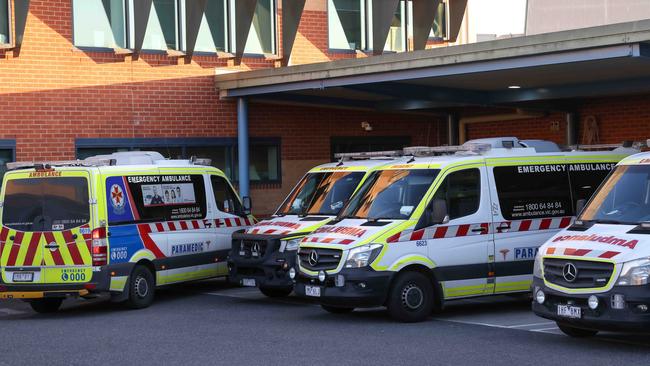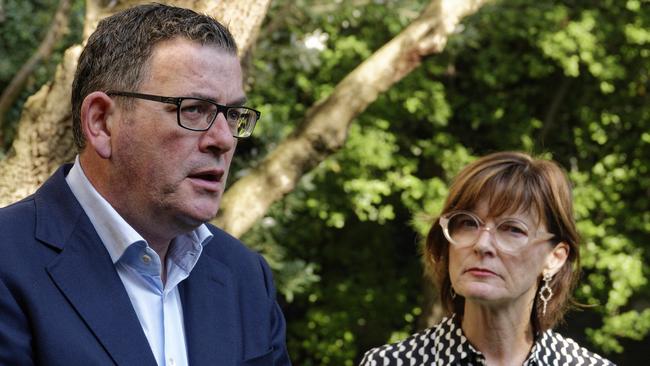Ambulance Victoria wait times: Code 1 response time target fail
New data reveals more than a third of “lights and sirens” patients waited too long for help. Plus how long is the elective surgery queue?

Victoria
Don't miss out on the headlines from Victoria. Followed categories will be added to My News.
Ambulance Victoria has failed to meet its performance targets again, with more than a third of urgent, “lights and sirens” patients waiting more than 15 minutes for help.
The latest quarterly health performance data, released on Tuesday, has shown the agency failed to meet its target to respond to 85 per cent of statewide Code 1 cases within 15 minutes between January and March of 2023.
They responded to 65.2 per cent of these cases in time, making this the 13th quarter in a row since the pandemic began that ambulances have missed the 85 per cent target.
It is the sixth quarter in a row with response targets below 70 per cent.
While times have improved by 5 percentage points compared to last quarter – when response times reached a new low of 60.2 per cent – they are still down compared to the same time period in the previous year.

Between January and March 2022, paramedics responded to 66.8 per cent of urgent cases in time.
But in other areas, Victoria’s under-pressure health system was showing greater signs of progress after several difficult years plagued by long wait times from emergency departments to elective surgery beds.
Premier Daniel Andrews said data on improved ambulance response times, a smaller elective surgery queue and virtual emergency department calls were “really, really positive” but acknowledged more work was needed.
“It is a long journey to repair and rebuild,” he said.
“We are turning this around, it is a big job.”
He said Covid would continue to place hospitals under increasing pressure over the coming months, with more than 300 patients now in hospital, but we would “get through” it.
“Heading into winter, we know that there are more Covid cases out there,” he said.
“It will be a challenging winter. There’s never been an easy winter in any hospital system anywhere in the world.”
Health Minister Mary-Anne Thomas said: “While we are seeing improvements across the board – we know there’s more to be done.”
“So we will continue to deliver the staff, services and infrastructure Victorians need to get the care they deserve,” she said.
Victorian ambulance union general secretary Danny Hill said there’s still “enormous pressure” but praised data showing call-takers’ “fantastic” work diverting 37,825 non-urgent triple-zero calls to secondary triage.
“That’s really where future investment needs to be really targeted,” he said.
Emergency department presentations dropped to 469,469 in the first three months of the year, compared to 488,629 between October and December 2022.
The Andrews government attributed the drop to the state’s Victorian Virtual Emergency Department and Priority Primary Care Centres (PPCC), with the former treating more than 100,000 Victorians and diverting 16,000 from emergency departments to PPCC.

Median emergency department wait times dropped to 18 minutes — which the government said was on par with pre-pandemic wait times — and 67.9 per cent of patients were treated in time, the highest result in more than a year.
However the amount of patients staying in the emergency department longer than 24 hours spiked with 2,497 Victorians (0.53 per cent of patients), compared to 2,304 last quarter and 492 in the same time period last year.
While it was lower than July to September 2022, when 3,665 patients were left waiting, that time period is often busier than the first three months of the year due to an increase in seasonal illnesses.
The number of patients on the elective surgery wait list has decreased for the fifth quarter in a row to 78,909 after the busiest quarter since 2019.
The hardest hit Victorians are waiting more than four years for elective surgery, well short of the expected 365 day time frame.
At the Women’s at Sandringham, some category three patients are waiting more than four years for surgery, with the average delayed patient spending more than 1150 days overdue as of March 31 this year.
Five other hospitals - Dandenong, Royal Melbourne, Casey, Healesville and Yarra Valley Health, and Box Hill - had wait times of more than two years for the average overdue category 3 patient.
Overall, the median wait time for non-urgent cases across the state fell to 143 days.
More than 46,500 procedures were completed, with the government praising their $1.5bn Covid catch-up plan and new public surgical centres in Blackburn and Frankston.
But more than one quarter (25.8 per cent) of patients were still forced to wait longer than the recommended time frame for their surgery.
This result was similar to last quarter (24.77 per cent) but lower than this time last year, when less than 18 per cent of patients had their operations outside of the recommended time frame.
The median wait time also increased again, rising from 35 days in the previous quarter for patients across all categories to 39 days.

Compared to this time last year, the wait has more than doubled, from 19 to 39 days.
The number of patients on the urgent category one waiting list jumped from 1799 last quarter – and 2566 the previous quarter – to 2613 in the first three months of 2023.
Category one patients need to be treated within 30 days, 99.09 per cent of whom were.
The government pointed to metrics where there has been improvement, such as Category 3 median wait times, which have dropped from 158 days last quarter (and 164 days this time last year) to 143 days.
Category 3 patients should be seen within 12 months, or 365 days.
Another metric highlighted as a positive by the government was Category 2 median wait times, which have dropped when compared to the same time last year (81 median days to 100).
But when compared to the previous quarter, median wait times for Category 2 patients had worsened slightly, from 77 days between October and December 2022 to 81 days between January and March 2023.
Category 2 patients should be seen within 90 days.
The government’s release also hit out at the federal government, and criticised the primary care system – which falls under federal responsibility, noting Victoria had a “primary health system that isn’t free, fast and local as it should be”.
Shadow ambulance services minister Georgie Crozier slammed the figures, and said response targets were still not being met six months after an election where Daniel Andrews vowed “to fix the crisis that has plagued our ambulance system”
“It’s clear nothing has changed. And it’s Victorians who suffer,” she said.
“This is the Victorian health system under the Andrews government – no guarantee you’ll get an ambulance and no plan to fix it.”

But the Victorian Healthcare Association – the peak body for Victoria’s public hospitals – welcomed the data, particularly the rise in elective surgery activity, but acknowledged more needed to be done.
VHA chief executive Leigh Clarke called on the federal government to increase their funding share of hospitals, and offer more support for primary care.
She said the data suggests “our health system is slowly starting to recover from an extremely challenging period, but we’re a long way from where we were in 2019”.
“We hope to see more support for Victoria’s health system from the Commonwealth government in the upcoming budget – through the Medicare reforms to support GPs and nurses, and through fairer, 50:50 funding for public hospitals.”
She praised the spike in elective surgery, and said the data showed hospitals were averaging 517 operations a day compared to 311 this time period last year.
“Our hospitals are doing more surgery than they did before the pandemic, which is cutting waiting times for care,” she said.
“It’s a great result given we still have a severe health workforce shortage in Victoria. It shows the state government’s catch-up plan is starting to work.”
Ambulance Services Minister Gabrielle Williams said the paramedics worked “incredibly hard”.
“We’ll continue to back them with more ambulances, more staff, more training and more equipment so they can keep doing what they do best – saving Victorian lives,” she said.
Ambulance Victoria metropolitan regional director Ian Hunt said a 7.8 per cent drop in demand and reduced levels of staff sickness had helped improve their Code 1 response time compared to last quarter.
“That’s 7825 fewer cases, which provided some welcome relief to our hard-working paramedics who had faced rising demand during the pandemic,” Mr Hunt said.
“We thank the community for helping us relieve pressure on our paramedics and the health system by saving triple-0 for emergencies.”
But he warned as colder weather approached the demand for ambulances would increase.
“However, now is not the time to be complacent,” he said.
“We know demand is already rising again and will continue to do so as we head towards winter.
“That’s why I encourage all Victorians take care of themselves and keep regular check-ups with your GP or specialist and get your Covid booster and annual flu shot.”
More Coverage
Originally published as Ambulance Victoria wait times: Code 1 response time target fail




